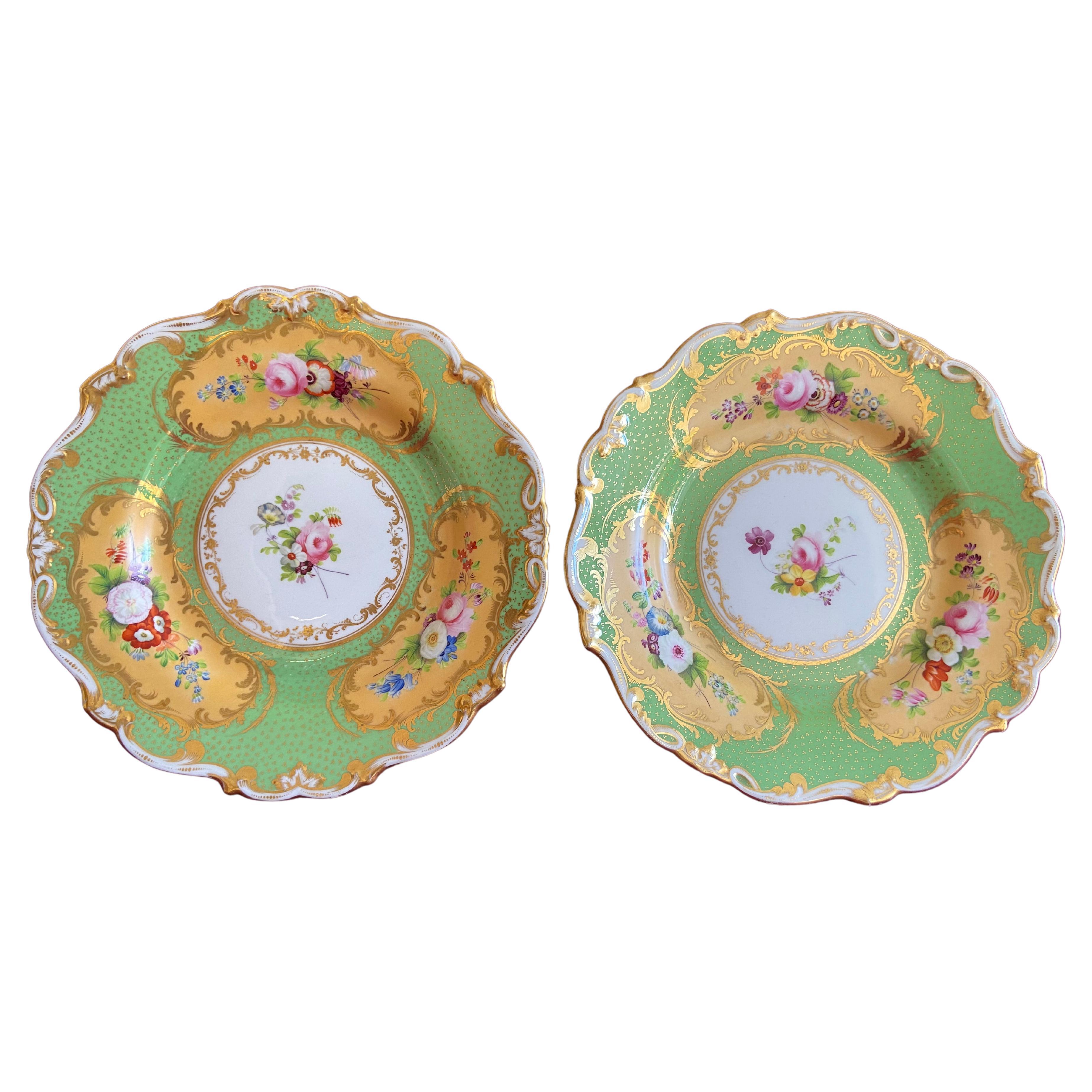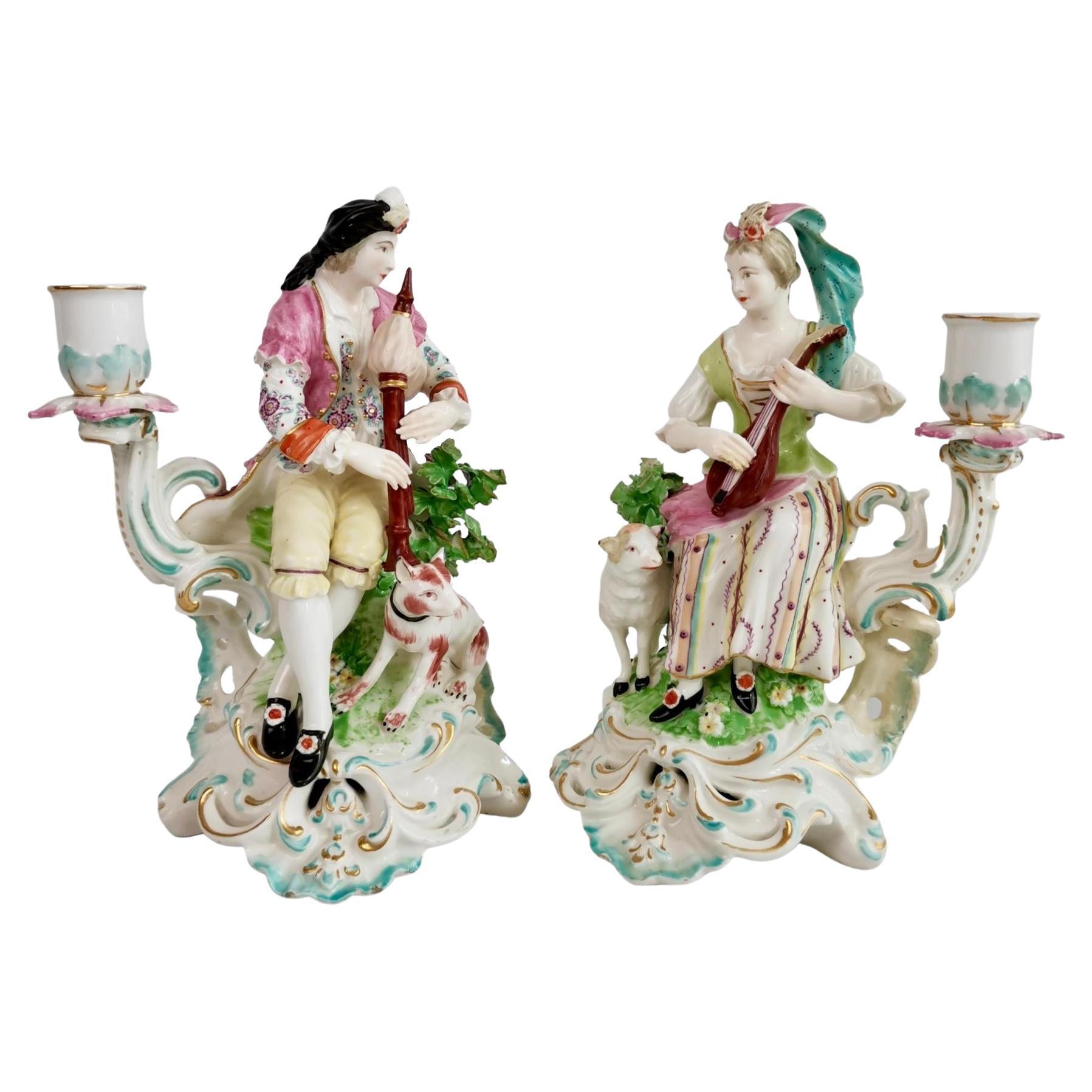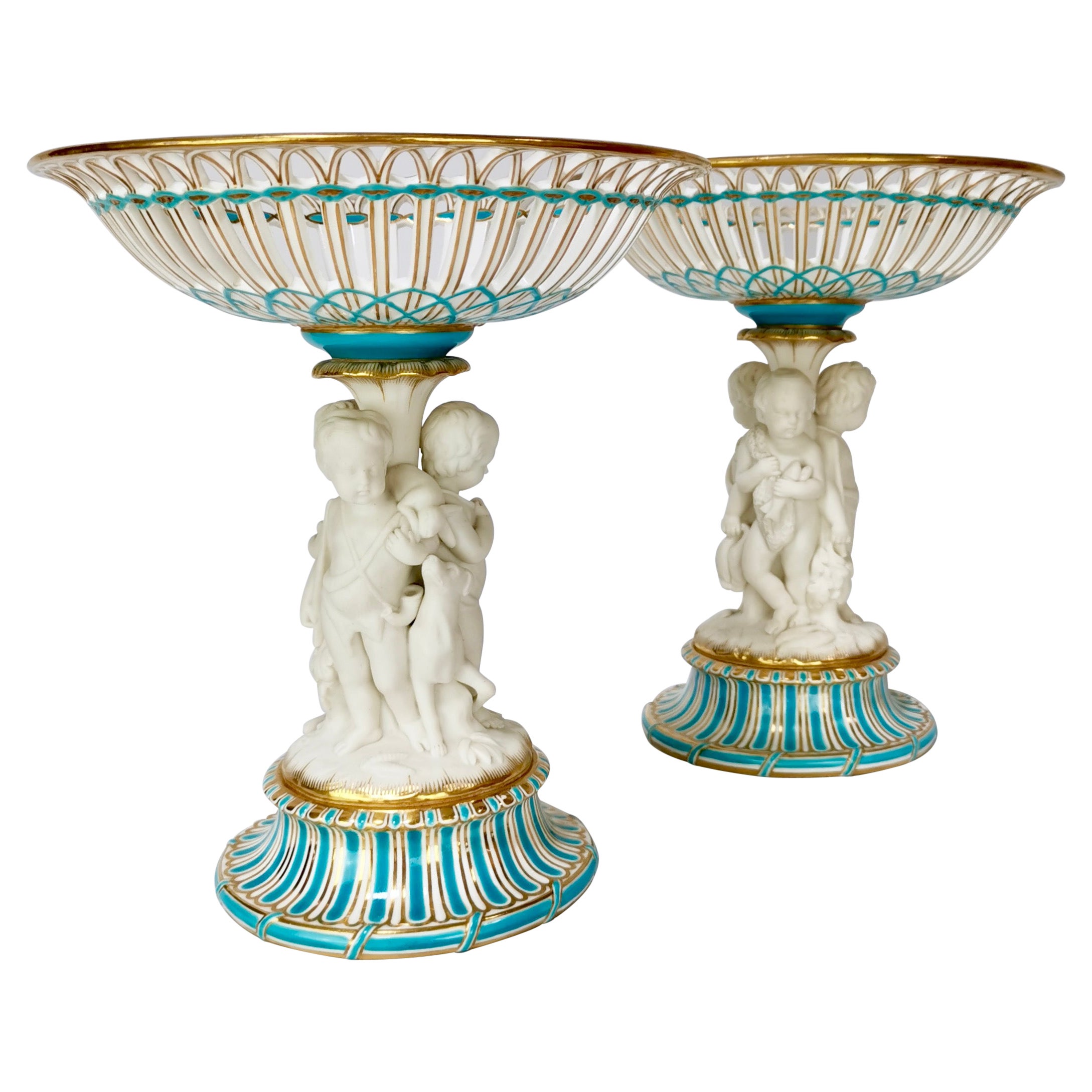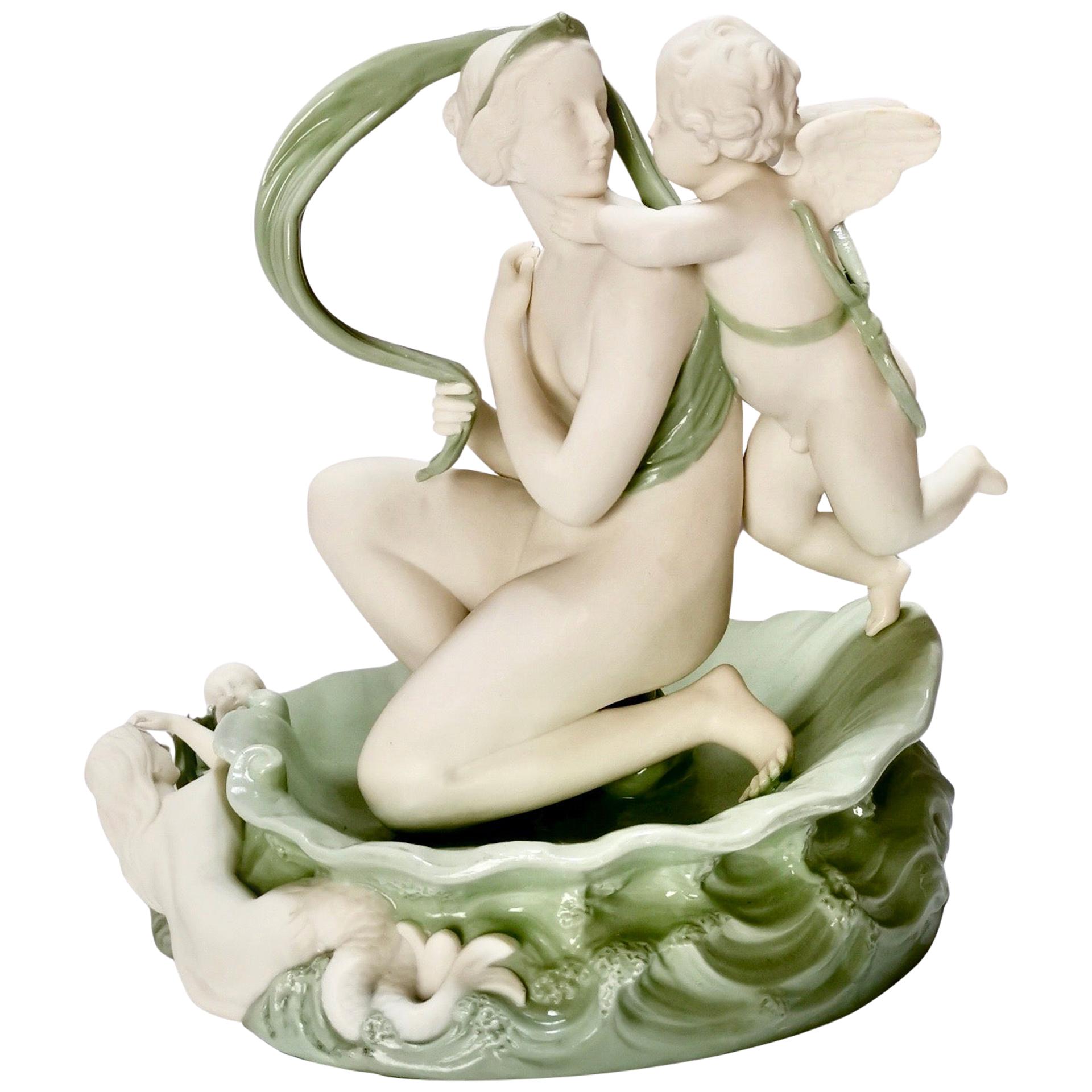Items Similar to Minton Pair of White Biscuit Figures of Gardener and Lady, ca 1835
Want more images or videos?
Request additional images or videos from the seller
1 of 18
Minton Pair of White Biscuit Figures of Gardener and Lady, ca 1835
About the Item
This is a very charming pair of white biscuit figures made by Minton in around 1835. The pair is actually a near-pair: the gentleman is a gardener with a basket of fruit, the lady has a garland of flowers and they each actually belonged to different companions, but go together perfectly.
Minton was one of the pioneers of English china production alongside other great potters such as Spode, Davenport, Ridgway, Coalport and others. They were located in Staffordshire and were known specifically for their wonderfully fine white bone china and bright colours; there is a colour called "Minton Blue" which is a fresh azure blue that was very fashionable during the Victorian era. Throughout the different phases of its existence, the factory made top quality creamware, porcelain, majolica and ultimately the finest parian porcelain. Minton excelled in their decorations and gilt work; these were often executed by artists who came from the Sèvres factory in France and brought their skills with them.
The male figure can be found in Geoffrey Godden's book "Minton Pottery & Porcelain of the First Period 1793-1850" in plate 146.
Figures like these were used to adorn the dinner table when dessert was served; groups of figures could serve to express something about the host, the guests, or to direct the conversation. Dancers and musicians were popular among these figure series. Minton used the figures a lot on candle sticks and the foots of high tazzas.
The figures are unmarked as is usual for figures of this particular era. The male one has an inscribed "No 09" on the underside, which is a mystery as the actual number of this figure in the Minton shape book is 192.
Condition Report: The figures are in excellent restored condition. They have a little bit of dirt on them, that can probably be washed off carefully. Both the male and the female have an arm that has been broken off and was restored; the male head is also placed back after a break. The restorations have been done well and don't stand out, and you can see them in the last two pictures.
Antique British porcelain is never perfect. Kilns were fired on coal in the 1800s, and this meant that china from that period can have some firing specks from flying particles. British makers were also known for their experimentation, and sometimes this resulted in technically imperfect results. Due to the shrinkage in the kiln, items can have small firing lines or develop crazing over time, which should not be seen as damage but as an imperfection of the maker's recipes, probably unknown at the time of making. Items have often been used for many years and can have normal signs of wear, and gilt can have signs of slight disintegration even if never handled. I will reflect any damage, repairs, obvious stress marks, crazing or heavy wear in the item description but some minor scratches, nicks, stains and gilt disintegration can be normal for vintage items and need to be taken into account.
There is widespread confusion on the internet about the difference between chips and nicks, or hairlines and cracks. I will reflect any damage as truthfully as I can, i.e. a nick is a tiny bit of damage smaller than 1mm and a chip is something you can easily see with the eye; a glazing line is a break in the glazing only; hairline is extremely tight and/or superficial and not picked up by the finger; and a crack is obvious both to the eye and the finger.
Dimensions: to be added.
- Creator:Minton (Maker)
- Dimensions:Height: 1 in (2.54 cm)Diameter: 1 in (2.54 cm)
- Sold As:Set of 2
- Style:Victorian (Of the Period)
- Materials and Techniques:
- Place of Origin:
- Period:
- Date of Manufacture:circa 1835
- Condition:Repaired: Both figures have one arm restored, and the gardener's head has been placed back. The repairs have been done well and can be seen in the last two pictures. Minor losses. In excellent restored condition.
- Seller Location:London, GB
- Reference Number:
About the Seller
5.0
Platinum Seller
These expertly vetted sellers are 1stDibs' most experienced sellers and are rated highest by our customers.
Established in 2016
1stDibs seller since 2019
208 sales on 1stDibs
Typical response time: <1 hour
- ShippingRetrieving quote...Ships From: London, United Kingdom
- Return PolicyA return for this item may be initiated within 14 days of delivery.
More From This SellerView All
- Derby Pair of Candle Stick Figures, Bagpiper and Lady with Lute, Rococo, Ca 1765By DerbyLocated in London, GBThis is a beautiful pair of Derby porcelain candlestick figures of a bagpiper and a lady with lute, made between 1759 and 1769, which was the Rococo era. The pair is one of Derby's f...Category
Antique 1760s English Rococo Figurative Sculptures
MaterialsPorcelain
- Minton Pair of Tazzas, White Parian Porcelain Cherubs Hunting, Victorian ca 1880By MintonLocated in London, GBThis is a spectacular pair of tazzas or comports made by Minton in about 1880, which was the Victorian era. The stems of the tazzas hold three white Par...Category
Antique 1780s English Victorian Centerpieces
MaterialsPorcelain
- Bow Pair of Porcelain Figures, Arlecchino and Columbina, Rococo ca 1758By Bow PorcelainLocated in London, GBThis is a wonderful pair of figures of Arlecchino and Columbina, made by the Bow Porcelain factory in about 1758. These figures formed part of a series of the Commedia dell'Arte, a very popular series of theatrical figures that served as decoration at the dinner table in the 18th Century. The Bow Porcelain Factory was one of the first potteries in Britain to make soft paste porcelain, and most probably the very first to use bone ash, which later got perfected by Josiah Spode to what is now the universally used "bone china". Bow was the main competitor of the Chelsea Porcelain Factory, but where Chelsea made very fine slipcast porcelain, Bow made a different soft paste porcelain that tended to be softer and could be pressed into moulds. Bow served a larger public generally at lower prices. The factory was only in operation between 1743 and 1774, after which the tradition got incorporated into some of the later famous potteries such as Worcester and Derby. These figures were used to adorn the dinner table when dessert was served; groups of figures served to express something about the host, the guests, or to direct the conversation. The Italian Commedia Dell'Arte, a comical form of masked theatre, was very popular in those days and Bow copied many figures of the German Meissen series that were brought out in the decades before. This pair dates from about 1758, which was at the height of Bow's ability to make beautiful figurines often copied from Chelsea or Meissen. The pair is modelled after a Meissen pair by Kaendler. The porcelain is translucent with a beautiful milky glaze - Bow was probably the first pottery using bone in its porcelain recipe. Arlecchino (Harlequin) is playing the bagpipes, dressed in an odd costume of mismatched chintz and playing cards and wearing a funny black trumpet...Category
Antique 1750s English Rococo Figurative Sculptures
MaterialsPorcelain
- Minton Celadon Parian Porcelain Sculpture, Venus and Cupid, Victorian, 1861By MintonLocated in London, GBThis is a beautiful celadon parian porcelain figure group made by Minton in 1861, which was the Victorian era. The group is of Venus and her son Cupid, seated in a shell. Minton w...Category
Antique 1860s English Victorian Figurative Sculptures
MaterialsPorcelain
- White Parian Figures, L'Enfant Lisant et L'Enfant Écrivant, after Lemire 19thCBy MintonLocated in London, GBOn offer is a superb pair of white parian figures, probably English and made in Staffordshire in the late 19th Century. The figures are after a pair of bronze models created by Charl...Category
Antique Late 19th Century English Victorian Figurative Sculptures
MaterialsPorcelain
- Minton Dessert Service, Inverted Shell White with Monochrome Flowers, ca 1830By MintonLocated in London, GBThis is a stunning dessert service made by Minton probably around the year 1830, in their "second period". The service consists of a high footed centre piece, two square dishes, two ...Category
Antique 1830s English Rococo Revival Dinner Plates
MaterialsPorcelain
You May Also Like
- Fine Pair of Minton Porcelain Dessert Plates C.1835By MintonLocated in Exeter, GBA very fine pair of Minton porcelain dessert plates c.1835. Finely decorated with panels of flowers on a yellow ground set within a green ground bord...Category
Antique 19th Century British Porcelain
MaterialsPorcelain
- Minton Antique Blanc de Chine Porcelain Figural CentrepieceBy MintonLocated in Bishop's Stortford, HertfordshireA fine antique Minton porcelain blanc de chine centrepiece with a young maiden with a basket dating from around 1862. The centrepiece stands o...Category
Antique 1860s English Victorian Porcelain
MaterialsPorcelain
- Pair of English Majolica Parrot Figures by MintonsBy MintonLocated in West Palm Beach, FLPair of English Majolica parrot figures by Mintons, each one with colorful feathers, resting on a perch.Category
Early 20th Century English High Victorian Pottery
MaterialsMajolica
- Pair of Sitzendorf Figures Porcelain Flower Sellers, German Fully Marked Ca 1920By SitzendorfLocated in Lincoln, LincolnshireThese are a beautiful PAIR of porcelain Figures or Figurines made by Sitzendorf, Germany, circa 1920. The figures are finely modelled in very good detail. They depict two flower s...Category
Early 20th Century German Country Porcelain
MaterialsPorcelain
- Large Meissen Pair Of Gardener Figurines, By Kaendler & Schoenheit, Ca 1860By Meissen Porcelain, Johann Carl Schoenheit, Johann Joachim KaendlerLocated in Vienna, ATGardener couple consisting of two individual figures. The female gardener wears rural rococo clothing: a dress with elaborate floral decoration and pinne...Category
Antique Mid-19th Century German Baroque Porcelain
MaterialsPorcelain
- Fred Cooke for Minton Art Deco Pierrette Porcelain FigurineBy MintonLocated in Bishop's Stortford, HertfordshireA rare Minton Art Deco porcelain figurine titled Pierette designed by Fred Cooke and dating from around 1930. This delightful standing figurine stands moun...Category
Vintage 1930s English Art Deco Figurative Sculptures
MaterialsPorcelain
Recently Viewed
View AllMore Ways To Browse
Antique Glazing Furniture
Pair Lady
Antique White Stain
Antique White Stain Furniture
Antique White Wash
Chinese Antique British Furniture
Antique White Washed Furniture
White Wash Antique Furniture
Antique Pottery Figures
Pair Of White Pottery
White Porcelain Figures
Finger Foot
Antique Garden Book
Vintage Garden Sculpture
Antique Small Decorative Plates
Antique Pottery Garden
Spode Chinese
Spode China





